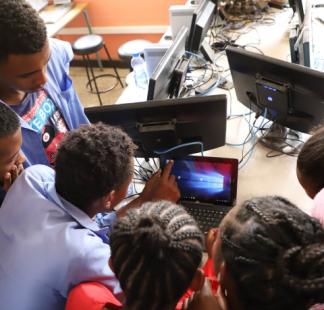- Daniel Nunes
- Gustavo Fonseca Ribeiro
- Alex Högback
- Rosimara Beatriz Arci Salgado
- Carolina Anselmino
- ICC Educação Continuada
Intermediate
Event Organizer(s)


Initiative

Description
The 'financing school connectivity'course is a 16-hour program designed to provide policymakers and government officials with a specialized and actionable understanding of financing school connectivity. The curriculum is focused on the financial landscape, dedicating its first two sections to a thorough exploration of the school connectivity financing ecosystem. Participants will dissect diverse funding sources—public, private, and international—and compare various financing models, including public-private partnerships (PPPs), blended finance, and other innovative approaches.
The latter two sections then delve into a comprehensive suite of funding mechanisms specifically engineered to mitigate investment risks in school connectivity projects. This includes a detailed examination of grants, subsidies, guarantees, sovereign funds, co-investment strategies, advance market commitments, and creative financial solutions such as bonds, notes, loans, and microfinance tailored for the educational context. This course aims to equip leaders with specialized financial knowledge to analyze, plan, and mobilize diverse resources effectively, ensuring sustainable and equitable digital transformation in schools.
This course is specifically designed for policymakers, public managers, and strategic leaders from key government bodies, including Education, Finance, ICT/Communications, and Planning. The program is tailored for decision-makers and professionals who are responsible for planning, funding, and overseeing large-scale initiatives and require a robust, actionable understanding of how to structure and finance school connectivity.
Participation is open to all, with preference accorded to applicants from countries and territories collaborating with the Giga initiative: Anguilla, Antigua and Barbuda, Barbados, Belize, Benin, Bosnia and Herzegovina, Botswana, Brazil, British Virgin Islands, Burundi, Cambodia, Djibouti, Dominica, Dominican Republic, El Salvador, Eswatini, Fiji, Gambia, Ghana, Grenada, Guatemala, Guinea, Honduras, Kazakhstan, Kenya, Kyrgyzstan, Lesotho, Liberia, Malawi, Moldova, Mongolia, Montserrat, Mozambique, Namibia, Niger, Panama, Rwanda, Saint Kitts and Nevis, Saint Lucia, Saint Vincent and the Grenadines, Sao Tome and Principe, Senegal, Sierra Leone, South Africa, Sri Lanka, Tanzania, Trinidad and Tobago, Uzbekistan, Zambia, Zimbabwe.
Members of the above-mentioned target population are invited to apply for the training if they meet the following criteria:
- Hold an undergraduate degree in a relevant field or have a minimum of three years of experience in the field if they do not hold a university degree.
- Possess an advanced level of English.
- Complete the application questionnaire and attach an up-to-date CV, a recommendation letter from their employer, and a motivation letter highlighting how the course applies to their current work.
Government officials and policymakers from developing countries, particularly women, are encouraged to apply.
Selection will be conducted by the course organizers, who will consider the above entry requirements along with an analysis of the application questionnaire, CV, and the recommendation and motivation letters of each applicant.
Number of available places for the cohort: 30
Upon completion of this course, participants will be able to:
- Analyze the diverse ecosystem of public, private, and international funding sources, and compare various financing models (including PPPs, blended finance, and other innovative approaches) applicable to achieving school connectivity.
- Evaluate a comprehensive suite of funding mechanisms—such as grants, subsidies, guarantees, advance market commitments, and co-investment strategies—for their effectiveness in mitigating investment risks associated with school connectivity projects.
- Examine the application of advanced financial solutions (including bonds, specialized loans, micro-finance) and the evolution of structural funds (e.g., "USAF 2.0 for Schools") to enhance the financial sustainability and reach of school connectivity initiatives.
- Formulate initial elements of strategic financial plans and actionable roadmaps, integrating diverse funding and risk mitigation mechanisms to effectively mobilize resources for bridging the digital divide in schools within their respective contexts.
To achieve the training objectives described, the course content will be delivered using an online instructor-led methodology, allowing the participants to access the course from anywhere and offering flexibility and convenience. Live sessions will be conducted through the Zoom platform, facilitating direct interaction between instructors and participants as well as among the participants themselves. This approach promotes real-time discussions, group work, and instant feedback, maintaining a dynamic and interactive learning environment.
The live lecture will take place as per the below schedule:
- Lecture one: 25 November 2025 1:00 PM CET Time
- Lecture two: 27 November 2025 1:00 PM CET Time
- Lecture three: 02 December 2025 1:00 PM CET Time
- Lecture four: 04 December 2025 1:00 PM CET Time
Structure per Section:
- 1 hour: Mandatory asynchronous pre-reading
- 1 hour 45 minutes: Synchronous interactive lecture
- 15 minutes: Synchronous break
- 1 hour: Synchronous practical group activity (in breakout rooms)
The assessment and grading methodology will include:
- An individual assignment submission
- A final multiple-choice quiz
The final test will contain 20 questions to provide a more comprehensive assessment. The questions are evenly distributed across the four module topics, with 5 questions dedicated to each topic, ensuring thorough coverage. To enhance the variety and challenge, the quiz includes Multiple Choice-Single Answer (MC-SA) and Multiple Choice-Multiple Answer (MC-MA) formats. Specifically, at least 5 out of the 20 questions are MC-MA, requiring the selection of multiple correct answers. Additionally, the order of the questions is randomized to prevent predictability and encourage a more robust evaluation of the students' understanding.
In addition to the final test, participants are also required to complete an individual assignment consisting of four tasks, one for each module of the course. In this assignment, participants are asked to analyze the content of each module in the context of their organization, industry and country/region. Each of the tasks must be answered in 300 to 500 words.
The deadline for submitting the individual assignment and the final test is December 12, 2025.
The grades will be distributed based on the following grading scale:
- Course final test (20 questions): 40%
- Individual assignment: 40%
- Active participation in live lectures: 20%
- Total: 100%
A total score of 70% or higher is required to obtain the ITU certificate.
Module 1: The School Connectivity Financing Ecosystem (Part 1) – Public, Private, and International Sources
- Distinguish between various public funding sources (budgets, USAFs, spectrum auction proceeds and processes) and analyze their application for school connectivity
- Identify potential private sector contributions (CSR, direct investment) and philanthropic funding avenues
- Assess the role and mechanisms of international organizations and Multilateral Development Banks (MDBs) in financing school connectivity
Module 2: The School Connectivity Financing Ecosystem (Part 2) – PPPs, Blended Finance, and Innovative Models
- Compare different Public-Private Partnership (PPP) models and their applicability to school infrastructure and services
- Formulate strategies for utilizing Blended Finance to de-risk investments and attract private capital for school connectivity
- Evaluate innovative financing models like Social/Development Impact Bonds for school-related outcomes
Module 3: Funding Mechanisms to Mitigate Investment Risks in Schools (Part 1) – Grants, Subsidies, Guarantees & Results-Based Financing
- Analyze how grants and subsidies (including from USAFs) can be structured to reduce investment barriers for school connectivity
- Assess the utility of various guarantee and insurance mechanisms in de-risking private investments in school connectivity and infrastructure
- Evaluate the potential of sovereign/co-investment funds to stimulate innovation and supply for schools
Module 4: Funding Mechanisms to Mitigate Investment Risks in Schools (Part 2) – Advanced Financial Solutions & Evolving Structural Funds
- Examine the applicability of creative financial solutions like bonds, notes, and specialized loans for financing large-scale school connectivity
- Explore how micro-finance and SME finance can empower small connectivity providers and local digital service entrepreneurs to strengthen the school digital ecosystem
- Conceptualize how structural funds (like USAFs) can evolve (USAF 2.0 for Schools) to incorporate more sophisticated financing and risk mitigation strategies for the education











